1.研究背景
随着互联网的发展与移动设备的普及,越来越多的人在社交媒体上分享个人图像。人像摄影流行的同时促进了人脸图像编辑技术的快速发展。传统的人脸图像编辑技术包括添加面部装饰(如眼镜、胡子)以及修饰容颜。基于生成对抗网络的人脸图像编辑方法能够改变人脸的固有属性(如年龄、性别)。人脸图像的年龄属性编辑技术在娱乐社交、影视媒体和智能安防等领域有着良好的应用前景和价值,能够广泛应用于人脸特效制作、帮助寻找失踪儿童、跨年龄段的人脸识别数据合成等任务。
2.图片演示
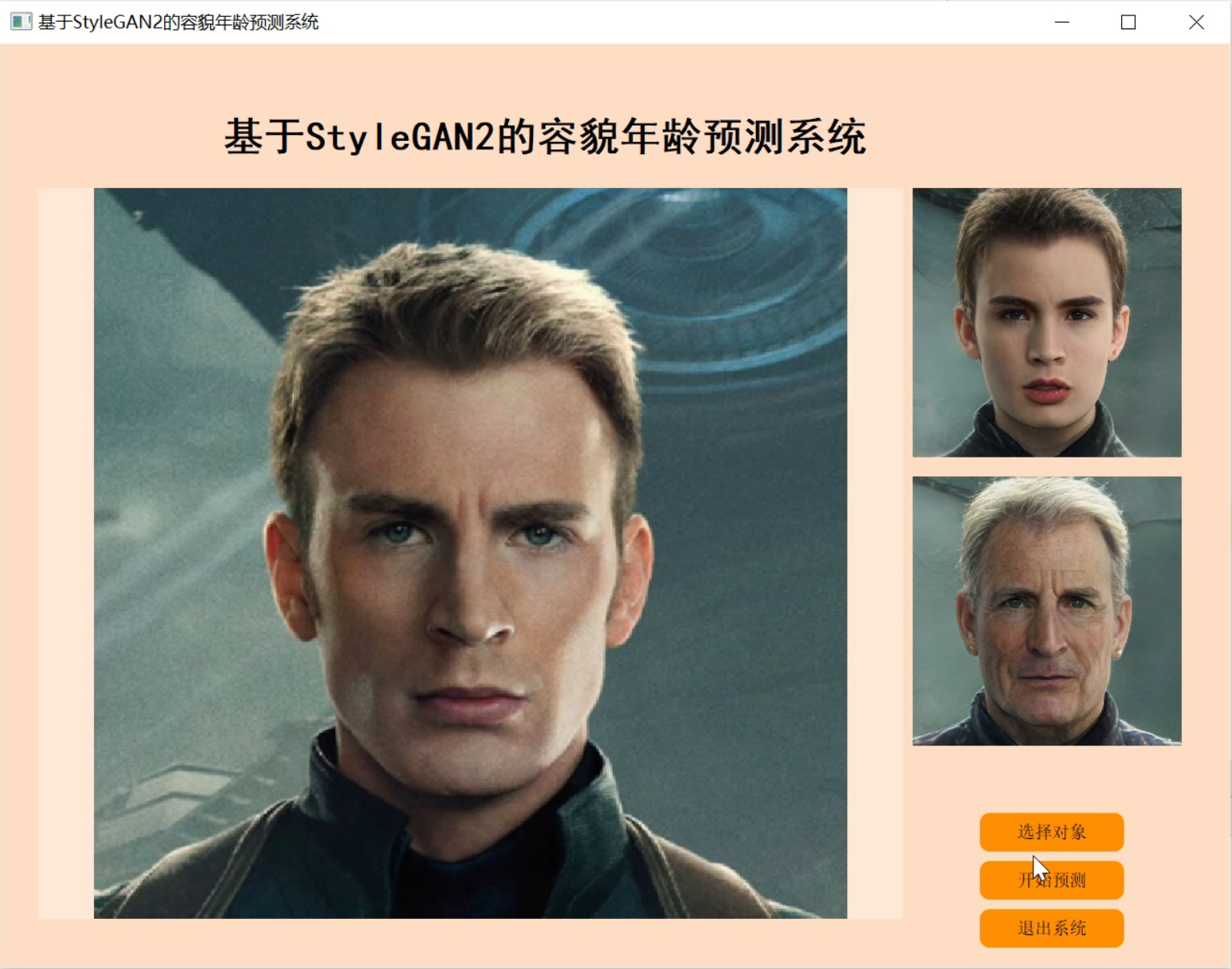
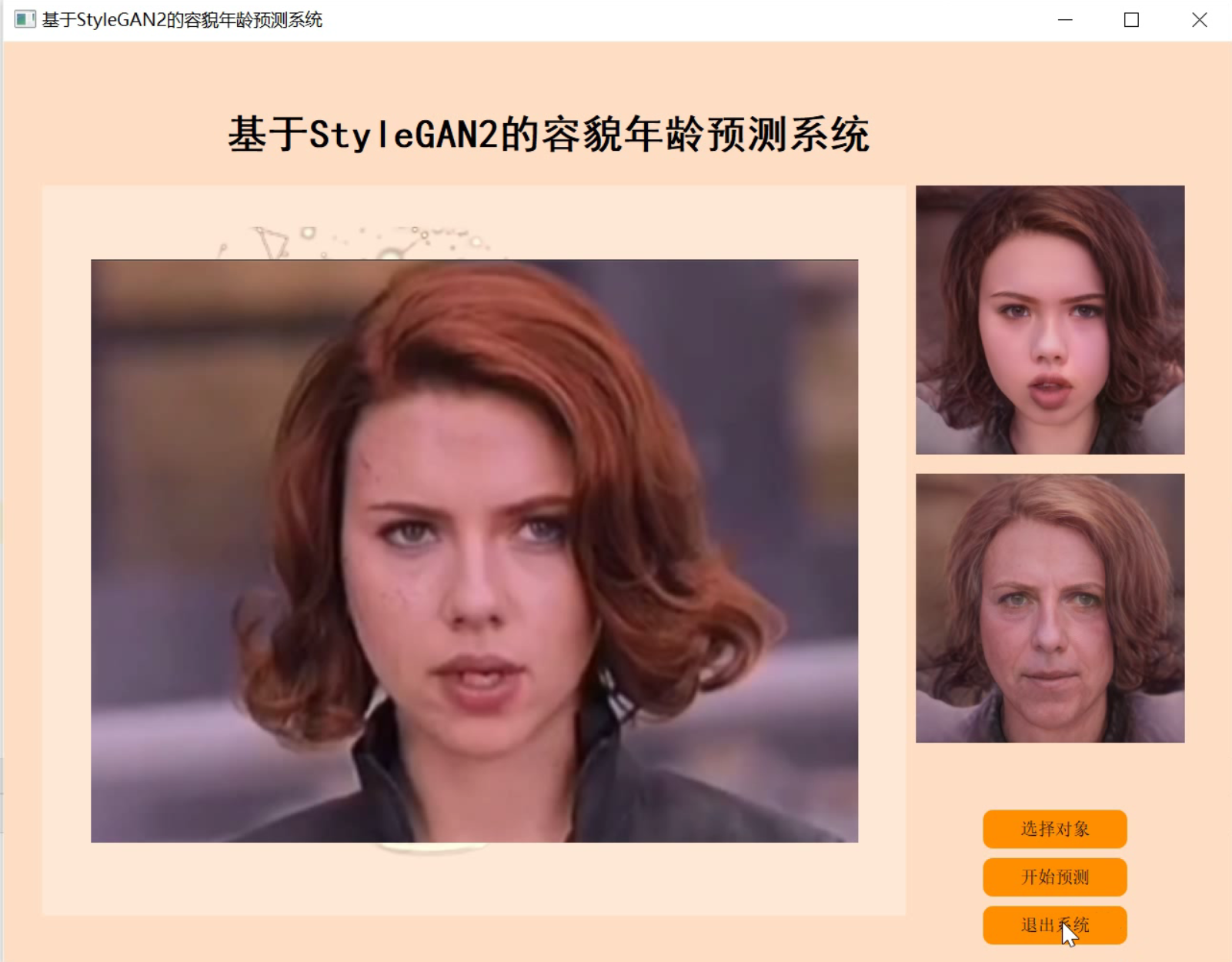
3.视频演示
改进StyleGANv2的容貌年龄预测系统(源码&教程)_哔哩哔哩_bilibili
4.StyleGAN2介绍
StyleGAN2 的出现当然是因为StyleGAN存在瑕疵,少量生成的图片有明显的水珠,这个水珠也存在于feature map上,如下图:
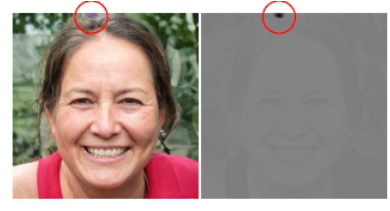
导致水珠的原因是 Adain 操作,Adain对每个feature map进行归一化,因此有可能会破坏掉feature之间的信息。emmmm,懵懵懂懂,最重要的是实验证明 当去除Adain的归一化操作后,水珠就消失了,所以Adain就背锅吧。
上面两张图说明了从 styleGAN 到 styleGAN2 ,在网络结构上的变换,去除normalization之后水珠消失了,但是styleGAN的一个亮点是 style mixing,仅仅只改网络结构,虽然能去除水珠,但是无法对style mixing 有 scale-specific级别的控制。
5.StyleGAN2 的改进点
AdaIN
StyleGAN第一个版本提出了通过AdaIN模块来实现生成,这个模块非常好也非常妙。
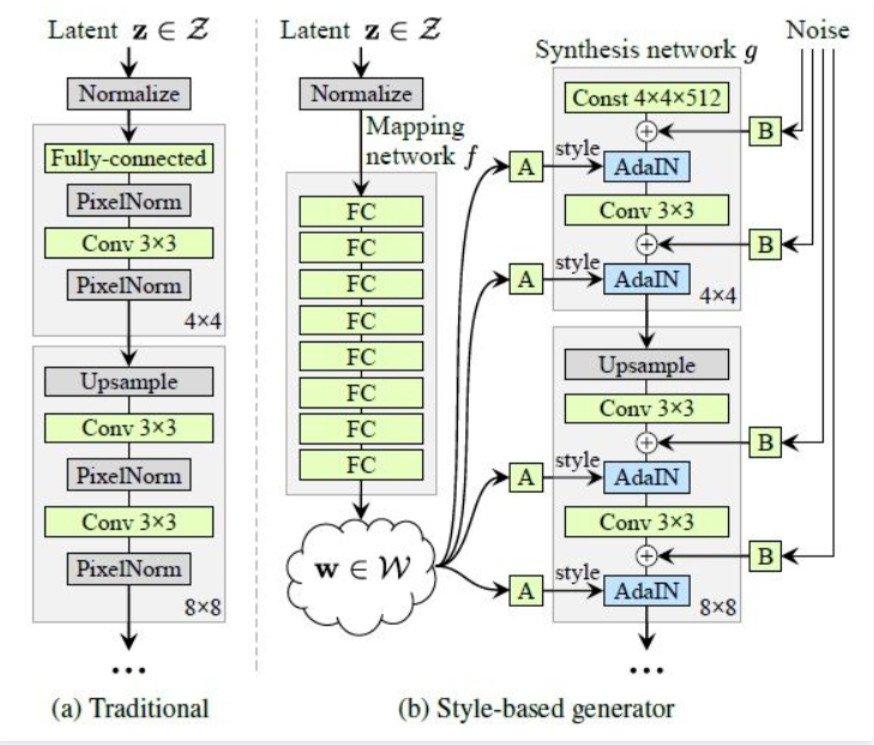
权重解调
虽然我们修改了网络结构,去除了水滴问题,但是styleGAN的目的是对特征实现可控的精细的融合。
StyleGAN2说,style modulation可能会放大某些特征的影像,所以style mixing的话,我们必须明确的消除这种影像,否则后续层的特征无法有效的控制图像。如果他们想要牺牲scale-specific的控制能力,他们可以简单的移除normalization,就可以去除掉水滴伪影,这还可以使得FID有着微弱的提高。现在他们提出了一个更好的替代品,移除伪影的同时,保留完全的可控性。这个就是weight demodulation。
我们继续看这个图:
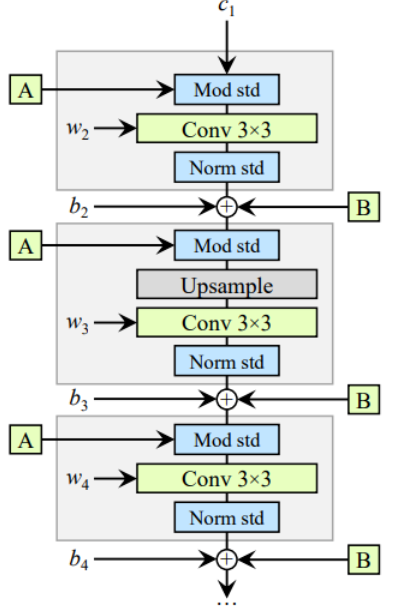
里面包含三个style block,每一个block包含modulation(Mod),convolution and normalization。
modulation可以影响着卷积层的输入特征图。所以,其实Mod和卷积是可以继续宁融合的。比方说,input先被Mod放大了3倍,然后在进行卷积,这个等价于input直接被放大了3倍的卷积核进行卷积。Modulation和卷积都是在通道维度进行操作。所以有如下公式:

接下来的norm部分也做了修改:

这里替换了对特征图做归一化,而是去卷积的参数做了一个归一化,先前有研究提出,这样会有助于GAN的训练。
至此,我们发现,Mod和norm部分的操作,其实都可以融合到卷积核上。
class GeneratorBlock(nn.Module):
def __init__(self, latent_dim, input_channels, filters, upsample = True, upsample_rgb = True, rgba = False):
super().__init__()
self.upsample = nn.Upsample(scale_factor=2, mode='bilinear', align_corners=False) if upsample else None
self.to_style1 = nn.Linear(latent_dim, input_channels)
self.to_noise1 = nn.Linear(1, filters)
self.conv1 = Conv2DMod(input_channels, filters, 3)
self.to_style2 = nn.Linear(latent_dim, filters)
self.to_noise2 = nn.Linear(1, filters)
self.conv2 = Conv2DMod(filters, filters, 3)
self.activation = leaky_relu()
self.to_rgb = RGBBlock(latent_dim, filters, upsample_rgb, rgba)
def forward(self, x, prev_rgb, istyle, inoise):
if exists(self.upsample):
x = self.upsample(x)
inoise = inoise[:, :x.shape[2], :x.shape[3], :]
noise1 = self.to_noise1(inoise).permute((0, 3, 2, 1))
noise2 = self.to_noise2(inoise).permute((0, 3, 2, 1))
style1 = self.to_style1(istyle)
x = self.conv1(x, style1)
x = self.activation(x + noise1)
style2 = self.to_style2(istyle)
x = self.conv2(x, style2)
x = self.activation(x + noise2)
rgb = self.to_rgb(x, prev_rgb, istyle)
return x, rgb
可以发现,这个噪音也会经过Linear层的简单变换,然后里面加入了残差。为什么要输出rgb图像呢?这个会放在下次,或者下下次的内容。styleGAN1是需要用progressive growing的策略的,而StyleGAN2使用新的架构,解决了这种繁琐的训练方式。
6.代码实现
def get_lr(t, ts, initial_lr, final_lr):
alpha = pow(final_lr/initial_lr, 1/ts)**(t*ts)
return initial_lr * alpha
def project(
imgs: List[PIL.Image.Image],
masks: List[PIL.Image.Image] = None,
generator = None,
pSp = None,
ckpt: arg_type(str, help="path to the model checkpoint") = None,
model_type: arg_type(str, help="inner model type. `ffhq-config-f` for default genrator and `ffhq-inversion` for pSp") = None,
size: arg_type(int, help="original output image resolution") = 1024,
style_dim: arg_type(int, help="dimensions of style z") = 512,
n_mlp: arg_type(int, help="the number of multi-layer perception layers for style z") = 8,
channel_multiplier: arg_type(int, help="channel product, affect model size and the quality of generated pictures") = 2,
start_lr: arg_type(float, help="learning rate at the begin of training") = 0.1,
final_lr: arg_type(float, help="learning rate at the end of training") = 0.025,
latent_level: arg_type(List[int], help="indices of latent code for training") = [0,1,2,3,4,5,6,7,8,9,10,11,12,13,14,15,16,17],
step: arg_type(int, help="optimize iterations") = 100,
mse_weight: arg_type(float, help="weight of the mse loss") = 1,
no_encoder: arg_type(
'project:no_encoder', action="store_true",
help="disable to use pixel2style2pixel model to pre-encode the images"
) = False,
):
n_mean_latent = 4096
transform = transforms.Compose(
[
transforms.Resize(256),
transforms.CenterCrop(256),
transforms.Transpose(),
transforms.Normalize([127.5, 127.5, 127.5], [127.5, 127.5, 127.5]),
]
)
_imgs = []
_masks = []
if masks is None:
masks = [Image.new(mode='L', size=img.size, color=255) for img in imgs]
for img, mask in zip(imgs, masks):
assert isinstance(img, PIL.Image.Image) and isinstance(mask, PIL.Image.Image)
img = paddle.to_tensor(transform(img))
mask = (paddle.to_tensor(transform(mask.convert('RGB')))[:1] + 1) / 2
_imgs.append(img)
_masks.append(mask)
imgs = paddle.stack(_imgs, 0)
masks = paddle.stack(_masks, 0)
percept = lpips.LPIPS(net='vgg')
percept.train() # on PaddlePaddle, lpips's default eval mode means no gradients.
if generator is not None:
no_encoder = True
if pSp is None:
no_encoder = False
if no_encoder:
generator = generator if generator is not None else get_generator(
weight_path=None if ckpt is None else ckpt,
model_type='ffhq-config-f' if model_type is None else model_type,
size=size,
style_dim=style_dim,
n_mlp=n_mlp,
channel_multiplier=channel_multiplier
)
# generator.eval() # on PaddlePaddle, model.eval() means no gradients.
with paddle.no_grad():
noise_sample = paddle.randn((n_mean_latent, style_dim))
latent_out = generator.style(noise_sample)
latent_mean = latent_out.mean(0)
latent_in = latent_mean.detach().clone().unsqueeze(0).tile((imgs.shape[0], 1))
latent_in = latent_in.unsqueeze(1).tile((1, generator.n_latent, 1)).detach()
else:
pSp = pSp if pSp is not None else get_pSp(
weight_path=None if ckpt is None else ckpt,
model_type='ffhq-inversion' if model_type is None else model_type,
size=size,
style_dim=style_dim,
n_mlp=n_mlp,
channel_multiplier=channel_multiplier
)
# pSp.eval() # on PaddlePaddle, model.eval() means no gradients.
generator = pSp.decoder
with paddle.no_grad():
_, latent_in = pSp(imgs, randomize_noise=False, return_latents=True)
latent_in = latent_in.detach().clone()
var_levels = list(latent_level)
const_levels = [i for i in range(generator.n_latent) if i not in var_levels]
assert len(var_levels) > 0
if len(const_levels) > 0:
latent_fix = latent_in.index_select(paddle.to_tensor(const_levels), 1).detach().clone()
latent_in = latent_in.index_select(paddle.to_tensor(var_levels), 1).detach().clone()
latent_in.stop_gradient = False
optimizer = optim.Adam(parameters=[latent_in], learning_rate=start_lr)
frames = []
pbar = tqdm(range(step))
latent_n = latent_in
for i in pbar:
t = i / step
lr = get_lr(t, step, start_lr, final_lr)
optimizer.set_lr(lr)
if len(const_levels) > 0:
latent_dict = {}
for idx, idx2 in enumerate(var_levels):
latent_dict[idx2] = latent_in[:,idx:idx+1]
for idx, idx2 in enumerate(const_levels):
latent_dict[idx2] = (latent_fix[:,idx:idx+1]).detach()
latent_list = []
for idx in range(generator.n_latent):
latent_list.append(latent_dict[idx])
latent_n = paddle.concat(latent_list, 1)
img_gen, _ = generator([latent_n], input_is_latent=True, randomize_noise=False)
frames.append(make_image(img_gen))
batch, channel, height, width = img_gen.shape
if height > 256:
factor = height // 256
img_gen = img_gen.reshape(
(batch, channel, height // factor, factor, width // factor, factor)
)
img_gen = img_gen.mean([3, 5])
p_loss = percept(img_gen*masks, (imgs*masks).detach()).sum()
mse_loss = F.mse_loss(img_gen*masks, (imgs*masks).detach())
loss = p_loss + mse_weight * mse_loss
optimizer.clear_grad()
loss.backward()
optimizer.step()
pbar.set_description(
(
f"perceptual: {p_loss.numpy()[0]:.4f}; "
f"mse: {mse_loss.numpy()[0]:.4f}; lr: {lr:.4f}"
)
)
img_gen, _ = generator([latent_n], input_is_latent=True, randomize_noise=False)
frames.append(make_image(img_gen))
imgs_seq = [[] for _ in range(img_gen.shape[0])]
for i in range(img_gen.shape[0]):
for frame in frames:
imgs_seq[i].append(frame[i])
return imgs_seq, latent_n
if __name__ == "__main__":
import argparse
import os
from utils import save_video
from crop import align_face
parser = argparse.ArgumentParser(
description="Image projector to the generator latent spaces"
)
parser, arg_names = func_args(parser, project)
parser.add_argument(
"--no_crop", action="store_true", help="disable to crop input images first"
)
parser.add_argument(
"--save_mp4", action="store_true", help="saving training progress images as mp4 videos"
)
parser.add_argument(
"files", metavar="FILES", nargs="+", help="path to image files to be projected"
)
parser.add_argument(
"--output", type=str, default="./output", help="output directory"
)
args = parser.parse_args()
imgs = []
masks = []
for imgfile in args.files:
if args.no_crop:
img = Image.open(imgfile)
imgs.append(img)
maskfile = '.'.join(imgfile.split('.')[:-1]) + '.mask.' + imgfile.split('.')[-1]
if os.path.exists(maskfile):
mask = Image.open(maskfile)
else:
mask = Image.new(mode='L', size=img.size, color=255)
masks.append(mask)
else:
img, mask = align_face(imgfile)
imgs.append(img)
masks.append(mask)
imgs_seq, latent_code = project(imgs, masks, **{arg_name: getattr(args, arg_name) for arg_name in arg_names})
os.makedirs(args.output, exist_ok=True)
for i, input_name in enumerate(args.files):
code_name = os.path.join(
args.output,
os.path.splitext(os.path.basename(input_name))[0] + ".pd"
)
latent_file = {
"latent_code": latent_code[i],
}
paddle.save(latent_file, code_name)
img_name = os.path.join(
args.output,
os.path.splitext(os.path.basename(input_name))[0] + "-project.png"
)
pil_img = Image.fromarray(imgs_seq[i][-1])
pil_img.save(img_name)
if args.save_mp4:
fps = 30
duration = 5
save_video(
imgs_seq[i],
os.path.join(
args.output,
os.path.splitext(os.path.basename(input_name))[0] + "-project.mp4"
),
fps, duration
)
7.系统整合
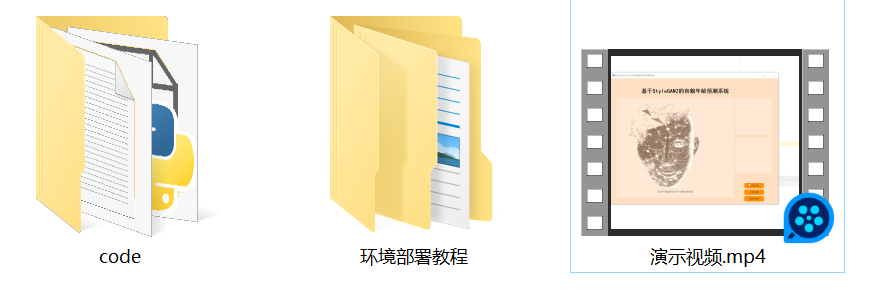
8.完整源码&环境部署视频教程&自定义UI界面
改进StyleGANv2的容貌年龄预测系统(源码&教程) (mianbaoduo.com)
9.参考文献
[1]徐莹.基于分层结构和稀疏表示的人脸老化模拟研究[J].中南大学.2012.DOI:10.7666/d.y2196806.
[2]Shuang Liu,Dan Li,Tianchi Cao,等.GAN-Based Face Attribute Editing[J].IEEE Access.2020.834854-34867.DOI:10.1109/ACCESS.2020.2974043.
[3]Lanitis, A.,Taylor, C.J.,Cootes, T.F…Toward automatic simulation of aging effects on face images[J].Pattern Analysis & Machine Intelligence, IEEE Transactions on.2002,24(4).442-455.
[4]Volker Blanz,Thomas Vetter.A Morphable Model For The Synthesis Of 3D Faces[J].Computer graphics.1999,33(0).
[5]Alfred Müller.Integral Probability Metrics and Their Generating Classes of Functions[J].Advances in applied probability.1997,29(2).429-443.DOI:10.1017/S000186780002807X.
[6]Bor-Chun Chen,Chu-Song Chen,Winston H. Hsu.Cross-Age Reference Coding for Age-Invariant Face Recognition and Retrieval[C].2014
[7]Jia Deng,Wei Dong,Socher, R.,等.ImageNet: A large-scale hierarchical image database[C].